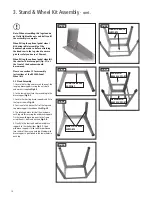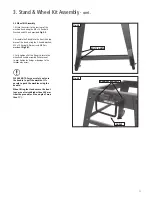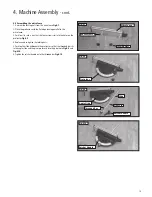
6
General Health & Safety Guidance - cont.
• A guard or other part that is damaged should be properly repaired
or replaced by a qualified person unless otherwise indicated in this
instruction manual.
• Do not use the machine if the switch does not turn the machine ‘ON’
and ‘OFF’.
• Have defective switches replaced by a qualified person.
31. Warning!
• The use of any accessory or attachment, other than those recommended
in this instruction manual, or recommended by our Company may present
a risk of personal injury or damage to the machine and invalidation of
the warranty.
32. Have your machine repaired by a qualified person
• This machine complies with the relevant safety rules and standards
appropriate to its type when used in accordance with these instructions
and with all of the standard safety guards and equipment in place. Only
qualified persons using original spare parts should carry out repairs.
Failure to do this may result in considerable danger to the user and
invalidation of warranty.
33. Caution! Motor may become hot during use
• It is normal for motors on some machines to become hot to the touch
during use. Avoid touching the motor directly when in use.
Safe Operation
1. Familiarise yourself with the machine
• Machining operations using bandsaws have a history of serious accidents.
Most result from contact with the moving blade while presenting material
to the blade or moving it from the table. Other minor accidents can occur
whilst setting, cleaning, adjusting or maintaining the machine.
• The machine is designed for cutting wood and composite board (plywood,
MDF etc.). Certain plastics can also be cut using a suitable blade.
2. Before switching the machine ‘ON’
• Ensure that the blade is correctly tensioned and aligned on the band
wheels and the blade guides are correctly adjusted.
• Ensure that the teeth of the blade are pointing downwards.
• Check the condition of the blade to ensure that no teeth are missing,
damaged or deformed and the blade is not cracked or split. If any of
these conditions apply, replace the blade immediately.
• Ensure that the saw blade type and width are suitable for the material to
be cut.
• Check that the blade width is within the minimum and maximum
permitted on the machine and that the thickness of the blade is suitable
for the diameter of the wheel.
• Some machines have more than one cutting speed. For most wood
cutting applications the faster of the speeds should be used.
• Check the condition of the table insert. Replace it immediately if it is
damaged or showing signs of wear.
• Adjust the guard as close as possible to the work piece being cut.
• Check that access doors are fully closed and that the latches are secure.
3. Whilst machining
• Never apply sideways pressure to the blade as this may cause the blade
to break.
• Care must be taken when cutting wood with knots, nails or cracks in
it and / or dirt on it, as these can cause the blade to get stuck. If this
happens, switch the machine ‘OFF’ immediately and follow the procedure
detailed in the manual to remove the blade from the work piece.
• If cutting cylindrical timber use a suitable jig to prevent twisting of the
work piece.
4. This machine falls under the scope of the ‘Health & Safety at Work etc.
Act 1974’, and the ‘Provision & Use of Work Equipment Regulations 1998’.
In addition the elimination or control of risks from wood dust is included in
the above regulations and the ‘Control of Substances Hazardous to Health
(COSHH) Regulations 2002’. We recommend that you study and follow
these regulations.
Further guidance can be found in the ‘Safety in the use of narrow bandsaws
– Woodworking sheet No.31’ and the ‘Safe use of woodworking machinery’
code of practice booklet (L114) published by Health & Safety Executive and
available from their website www.hse.gov.uk.
Additional Health & Safety for Bandsaws
Summary of Contents for BS300E Premium
Page 33: ...33 13 Parts Diagrams cont ...
Page 34: ...34 13 Parts Diagrams cont ...
Page 35: ...35 13 Parts Diagrams cont ...







































